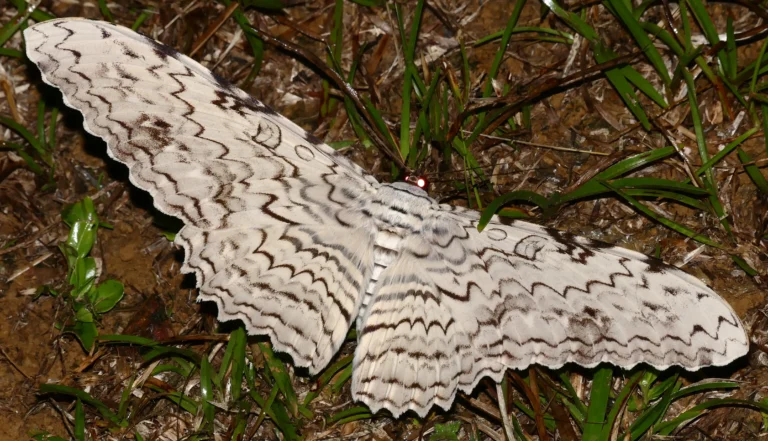25 Colorful And Pretty Moth Species: Challenging Ugly Myths
When most people hear the word “moth,” they often picture a plain, gray creature fluttering around their porch light. However, this image does an injustice to the stunning variety and beauty that moths bring to our world.
These winged wonders, including pretty moths and colorful moths, come in an array of dazzling colors and intricate patterns, rivaling even the most beautiful butterflies.
The common myth is that moths are just drab, dull insects that pale in comparison to their vibrant cousins. But dive a little deeper into their world, and you’ll discover pretty moths with a spectrum of colors, from shimmering golds to radiant blues, and designs so detailed they could be works of art.
In this journey, we’ll introduce you to the vibrant world of colorful moths, revealing the true colors behind these often misunderstood creatures. So, let’s set aside our preconceptions and explore the captivating universe of pretty and colorful moths.
Table of Contents
Discovering 25 of the Most Colorful & Pretty Moth Species from Around the World
1. Rosy Maple Moth (Dryocampa rubicunda)
- Habitat: Found mostly in Eastern North America.
- Size: Has a wingspan ranging between 32–55 mm.
- Description: This is a moth that looks like it’s jumped straight out of a fairy tale. The pastel pink and bright yellow colors blend, giving it a dreamy look. It also has a distinctly fuzzy appearance, which adds to its charm.
- Interesting Fact: Why the unique name? It’s pretty simple! The moth’s lovely rosy shades are reminiscent of a sunrise, and it often prefers laying its eggs on maple trees.
Discover more pink and yellow moths in our detailed guide.
2. Madagascan Sunset Moth (Chrysiridia rhipheus)
- Habitat: Native to the beautiful island of Madagascar.
- Size: A wingspan that measures between 70–90 mm.
- Description: A real showstopper, this moth boasts iridescent colors. It showcases a vivid palette of bright oranges, shimmering blues, and deep greens.
- Interesting Fact: Its breathtaking colors have often led to it being confused with a butterfly. Also, unlike many moths, this one is active during the day.
3. Atlas Moth (Attacus atlas)
- Habitat: Calls the tropical forests of Southeast Asia its home.
- Size: It’s a giant! With a wingspan that can extend up to 30 cm, it’s among the world’s largest moths.
- Description: Its large wings showcase intricate patterns that resemble a topographical map, with tawny shades, soft whites, and veiny outlines.
- Interesting Fact: The name “Atlas” is fitting both because of its size and the map-like patterns on its wings.
4. Garden Tiger Moth (Arctia caja)
- Habitat: Found across Europe and parts of North America.
- Size: A moderate wingspan of 45-65 mm.
- Description: A vibrant display of bright orange hindwings adorned with bold black spots makes this moth a visual treat. It’s as if it’s wearing a polka-dotted outfit!
- Interesting Fact: Those striking patterns aren’t just for show. They serve as a warning, telling predators, “Stay away! I might be toxic.”
5. Oleander Hawk-Moth (Daphnis nerii)
- Habitat: Spread across parts of Africa and Asia.
- Size: This moth boasts a wingspan of 70-100 mm.
- Description: A lovely blend of green shades with hints of pinkish-brown, its colors and sleek shape give it a streamlined look.
- Interesting Fact: Named after the oleander plant, this moth’s caterpillars have a special diet – they love munching on oleander leaves.
6. Cinnabar Moth (Tyria jacobaeae)
- Habitat: Primarily found in Europe and parts of West Asia.
- Size: It flaunts a wingspan of 32-42 mm.
- Description: The Cinnabar moth is a pretty sight with its striking red and black patterns. It’s almost as if it’s wearing a fashionable dress ready for a party!
- Interesting Fact: Here’s a fun twist: those bright colors are a signal. They tell predators, “Hey, I might not taste so good because I’m toxic.”
7. Luna Moth (Actias luna)
- Habitat: This beauty calls North America its home.
- Size: With a wingspan of 75-105 mm, it’s quite the sight!
- Description: Soft and dreamy, the Luna moth is colored a gentle pale green. It also has long, delicate tails on its hindwings, giving it a unique look.
- Interesting Fact: These colorful moths have a short adult life. They don’t even eat! With no mouthparts, they live just about a week, focusing solely on mating.
8. Io Moth (Automeris io)
- Habitat: Spread across North and Central America.
- Size: This one comes in at a wingspan of 60-90 mm.
- Description: A bright yellow or vivid red background adorned with large eye spots makes the Io moth stand out. It’s like nature’s own artwork!
- Interesting Fact: Those big eye spots aren’t just for beauty. When a predator comes close, the moth flashes its eye spots, giving the attacker a good scare.
9. Emperor Gum Moth (Opodiphthera eucalypti)
- Habitat: It lives in Australia’s green landscapes.
- Size: A wingspan of 100-150 mm ensures it doesn’t go unnoticed.
- Description: Soft brown and beige patterns dance across its wings. It’s a more understated beauty, but a beauty nonetheless.
- Interesting Fact: The name gives away a hint. This moth has a preference for eucalyptus trees, especially during its caterpillar days.
10. Death’s-head Hawkmoth (Acherontia)
- Habitat: Roaming in parts of Europe and Asia.
- Size: A sizeable wingspan of 90-130 mm.
- Description: This moth might sound scary, but it’s genuinely captivating. With a unique, iconic skull-like pattern on its thorax, it combines beauty with a touch of mystery.
- Interesting Fact: If you’re a movie buff, you might recognize it. This moth got some fame from its appearance in the film “The Silence of the Lambs.”
11. Comet Moth (Argema mittrei)
- Habitat: Found exclusively in the rainforests of Madagascar.
- Size: Impressive wingspan of up to 20 cm.
- Description: This beautiful moth is adorned with long, sweeping tails on its hindwings and a bright yellow and brown pattern that resembles a comet’s trail.
- Interesting Fact: Due to its striking appearance, it’s often considered one of the most impressive and beautiful moths in the world.
12. Lime Hawk-Moth (Mimas tiliae)
- Habitat: Distributed across Europe and Asia.
- Size: A decent wingspan of 65-80 mm.
- Description: Sporting shades of green and brown, this colorful moth blends seamlessly with lime tree leaves, its favorite resting spot.
- Interesting Fact: Its name gives away its favorite host plant – the lime tree.
13. Twin-Spotted Sphinx Moth (Smerinthus jamaicensis)
- Habitat: Native to North America.
- Size: With a wingspan of 70-100 mm, it’s hard to miss.
- Description: This beautiful moth displays soft shades of grey and brown and is adorned with two distinct spots on each hindwing.
- Interesting Fact: Its detailed wing pattern helps it blend in with tree bark during the daytime.
14. Galium Sphinx Moth (Hyles gallii)
- Habitat: Found across Europe, Asia, and North America.
- Size: A wingspan of 60-80 mm.
- Description: This pretty moth boasts pink and black bands on its abdomen, and its grey and black forewings provide a beautiful contrast.
- Interesting Fact: Its larvae have a varied diet and can feed on multiple plant species.
15. False Tiger Moth (Dysphania militaris)
- Habitat: Native to Southeast Asia.
- Size: A wingspan of 40-50 mm.
- Description: As the name suggests, this beautiful moth displays bright yellow and black patterns, mimicking the appearance of a tiger.
- Interesting Fact: Despite its appearance, it’s harmless and uses its colors to ward off potential predators.
16. Cecropia Moth (Hyalophora cecropia)
- Habitat: Found in North America.
- Size: With a wingspan of up to 15 cm, it’s one of the largest moths in North America.
- Description: This colorful moth has beautiful shades of red, white, and brown with crescent-shaped spots on the wings.
- Interesting Fact: Cecropia moths, like many others, have a very short adult lifespan and focus only on reproduction.
17. Giant Leopard Moth (Hypercompe scribonia)
- Habitat: Native to the eastern United States.
- Size: A wingspan of 50-80 mm.
- Description: With its stark white wings decorated with black spots, the giant leopard moth looks like a snowy night with stars scattered across the sky.
- Interesting Fact: The moth’s vibrant coloration serves as a warning to potential predators about its unpalatable taste.
18. Rothschildia aurota
- Habitat: Found in South America.
- Size: A wingspan of 100-120 mm.
- Description: The moth’s rich, deep shades of brown, complemented by translucent windows on its wings, make it a treat for the eyes.
- Interesting Fact: Rothschildia moths are often used in art and crafts because of their beautiful wing patterns.
19. Emperor Moth (Saturnia pavonia)
- Habitat: Distributed across Europe.
- Size: A wingspan of 60-80 mm.
- Description: This pretty moth sports bright eye spots on its wings and lovely shades of brown and orange.
- Interesting Fact: The emperor moth is one of the few moth species active during the day.
20. White Lined Sphinx Moth (Hyles lineata)
- Habitat: Found across the Americas.
- Size: A wingspan of 50-70 mm.
- Description: This beautiful moth is adorned with pink and black bands on its abdomen and has intricate white lines that run across its wings.
- Interesting Fact: It’s often mistaken for a hummingbird due to its hovering flight pattern.
21. Burnished Brass (Diachrysia chrysitis)
- Habitat: Europe
- Size: Wingspan of 28-35 mm
- Description: Boasts metallic green-gold patterns, making it one of the most uniquely pretty moths in its habitat.
- Interesting Fact: While brilliantly colored, they camouflage seamlessly amidst vegetation.
22. Purple Thorn (Selenia tetralunaria)
- Habitat: Europe and Asia
- Size: Wingspan of 38-45 mm
- Description: Dazzling purples and violets with scalloped edges make it a perfect example of colorful moths.
- Interesting Fact: Its appearance varies between spring and summer, with the latter being lighter.
23. Scarlet Tiger (Callimorpha dominula)
- Habitat: Western and Southern Europe
- Size: Wingspan of 45-55 mm
- Description: Features rich red underwings, contrasting beautifully with black and white spotted forewings.
- Interesting Fact: Its vibrant colors don’t deter it from being a dusk flyer.
24. Peacock Moth (Macaria notata)
- Habitat: Europe
- Size: Wingspan of 30-40 mm
- Description: Delicate white wings adorned with brown notched borders evoke the eyespots of a peacock’s tail.
- Interesting Fact: The caterpillar phase feeds on various deciduous trees.
25. The Herald (Scoliopteryx libatrix)
- Habitat: Europe
- Size: Wingspan of 40-45 mm
- Description: This moth is a deep orange-brown with distinctive curved white markings, an emblem of pretty moths.
- Interesting Fact: This species is known to overwinter as an adult, often found in dark, cool refuges.
Why Are Some Moths So Colorful?
Moths, with their incredible array of colors, might leave many wondering: why so colorful? While these beautiful hues and patterns serve as a feast for our eyes, they play crucial roles in the survival and reproduction of these fascinating creatures.
Evolutionary Benefits
Colors are not just for show; they’ve evolved over time to provide distinct advantages. For some moths, being colorful means blending in, while for others, it means standing out.
These colors help them evade predators, attract potential mates, and send essential messages within their species.
Role in Camouflage
Nature can be a dangerous place for a moth, especially with predators lurking around. The colors and patterns on some moths have evolved in such a way that they can seamlessly blend into their surroundings.
A bark-like pattern, leafy green hues, or even mimicking other harmful creatures can be the difference between life and death for these delicate insects.
Role in Mating
Like a well-tailored suit or a beautiful dress, colors play a pivotal role in attracting a mate. Bright and vivid patterns often indicate a healthy mate, which would in turn ensure healthier offspring. In the competitive world of moth mating, being colorful and pretty can give one a definite edge!
Conclusion
Moths are often overshadowed by the popular beauty of butterflies. However, as we’ve seen, they exhibit their own unique charm and splendor.
These pretty and colorful moths not only captivate our senses with their breathtaking designs but also play vital roles in the ecosystem. Their beauty and significance in nature remind us of the endless wonders that our environment holds.
Let us not take these beautiful creatures for granted. Their presence indicates a healthy environment, and they contribute to the balance of our ecosystems. By appreciating and ensuring the protection of these species, we’re not only safeguarding their future but ours as well.
Next time you spot a colorful moth fluttering about, take a moment to appreciate its beauty and remember its vital role in the circle of life.


